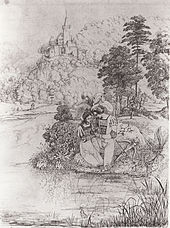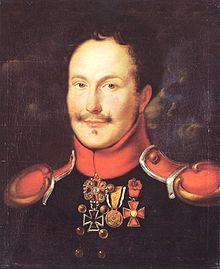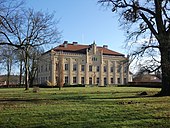Friedrich de la Motte Fouqué

Friedrich Heinrich Karl Baron de la Motte Fouqué (pseudonyms Pellegrin and ALT Frank * 12 February 1777 in Brandenburg an der Havel , † 23. January 1843 in Berlin ) was one of the first German poet of romance .
Life
Origin, youth and military service
Friedrich Heinrich Karl Baron de la Motte Fouqué (full name: Friedrich Heinrich Karl Baron de la Motte Fouqué, Baron de Thonnayboutonne, Baron de Saint-Surin, Seigneur de la Greve ) comes from a noble French Huguenot family from Brandenburg an der Havel. His godfather was Frederick the Great . He spent his childhood on his parents' estate in Sacrow near Potsdam , and later on Lentzke near Fehrbellin . Fouqué was brought up by changing private tutors (including Dietrich Arnold Friedrich Sachse and August Ludwig Hülsen ). Determined by his grandfather, Heinrich August de la Motte Fouqué (1698–1774) (General of the Prussian Army under Frederick II ), he joined the Prussian army at a very early age. At seventeen he already held the rank of ensign and took part in the Rhine campaign of 1794. He then served as a lieutenant in the cuirassier regiment of the Duke of Weimar in Aschersleben .
From 1798 he was married to Marianne von Schubaert, from whom he divorced in 1802. In the same year he resigned from the army.
New beginning
During his time in Weimar he had encounters with Goethe , Schiller and Herder . In 1803 he married the landowner Caroline von Rochow , born Caroline Philippine von Briest, who was two years his senior . Fouqué and his wife lived at Nennhausen Castle near Rathenow . Both were active as a writer. Fouqué initially published under the pseudonym Pellegrin . Fouqué's sponsor was August Wilhelm Schlegel , who published his Dramatic Games (1804).
This was followed by the romances from Thale Ronceval (1805), the novel History of the noble knight Galmy and a beautiful duchess from Brittany (1806), the novel Alwin (1808) and the heroic game Sigurd, the snake slayer (1808) - works that are in fabric , poetic conception and manner of representation already marked his later poetry. The war legends of the north and the French knight stories of the Middle Ages merged into a fantastic world.
Highlights of literary creation, return to the military
Between 1808 and 1820, Fouqué's life and poetry took off most. In 1811, Undine appeared in Berlin , a story interspersed with fantastic elements, partly in fairytale tones. This was followed by the chivalric novel The Magic Ring (Nuremberg 1812). In the same year, Fouqué's patriotism led him back to the Prussian army. He took part in the battles of the war of liberation as a lieutenant and cavalry master with the volunteer hunters , received his farewell as a major in 1815 and then lived again at Gut Nennhausen.
The journeys of Thiodulf, the Icelandic (Hamburg 1815), the small novels (Berlin 1814-19, 6 vols.), Sängerliebe (Stuttgart 1816) and The wonderful incidents of Count Alethes von Lindenstein (Leipzig 1817) were supported by the Neue Schauspiele ( Alf and Yngwi , the Irmensäule , Runenschrift ), gallant tragedies ( pilgrimage , the Jarl Orkney ), epic poems as Corona (Stuttgart 1814), d Charles. Size Birth and youth (Nuremberg 1814) and supplemented by countless short stories, dramas and adventures.
In 1818 Johann Leonhard Schrag published the two volumes Altsächsischer Bildersaal in Nuremberg , with a preface from 1817, including the dramas Herrmann, a heroic play in four adventures (412 pages) and (Volume II) Welleda and Ganna - An Old German Story (25 chapters on 688 Pages, with a privilege foreword by the royal Württemberg government, Freiherr von Holzschuher, Stuttgart 1817 and Carlsruhe 1818).
He also belonged to the circle of Serapion brothers around ETA Hoffmann.
Cuts, late times and ends

In 1818 Fouqué suffered a stroke . Then the stories Bertrand du Guesclin (Leipzig 1821), Knight Elidouc, Old Brittany Sage (Leipzig 1823), The Saga of Gunlaugar, called Dragon's Tongue, and Rafn the Skald appeared. An Icelandic customer in the 9th century (Vienna 1826), Jakob Böhme, a biographical memorial stone (Greiz 1831).
On friendship with Ernst von Rüchel , he wrote a two-volume biography (Berlin 1826) after his death, it was largely based on information from his adjutant and friend Johann von Brixen .
In 1831 his wife Caroline died. In 1833 he married the writer Albertine de La Motte Fouqué , who later published his estate, and lived in Halle (Saale) . This was followed by the empires at the beginning of the year 1835-40, seals (Hall 1835-40, 6 issues), Prussian mourning slogans and homage greetings for 1840 (Hall 1840). In 1841 he returned to Berlin and published the Selected Works, final edition (in twelve volumes). Even before his death, Der Pappenheimer Kürassier followed, scenes from the time of the Thirty Years War (Nordhausen 1842). He published (in community with Ludwig von Alvensleben ) the newspaper for the German nobility (Leipzig 1840–42).
Fouqué died in Berlin on January 23, 1843. His grave is in the old garrison cemetery in Berlin-Mitte , Kleine Rosenthaler Straße and Linienstraße.
The hometown of Brandenburg an der Havel honored its poet by naming the city library Fouqué Library on January 23, 1998.
Works
The best known is still the Undine . His work experienced a revival and a series of new editions and reprints through the biography of Arno Schmidt : Fouqué and some of his contemporaries (1958).
The literary legacy of Friedrich de la Motte Fouqué is also cultivated in the Kleist Museum in Frankfurt (Oder).
Publications during his lifetime (selection)
- Dramatic games , Berlin, Unger 1804. Digitized
- Romances from Thale Ronceval , Berlin, 1805
- History of the noble knight Galmy and a beautiful duchess from Brittany , 1806. 1st part online
- Alwin , 1808. Vol.1 online , Vol.2
- The hero of the north , 1810. Vol.1 online , Vol.2 , Vol.3
-
Undine , 1811, digitized version and full text in the German text archive
- Libretto for the opera Undine based on his own original, set to music by ETA Hoffmann , WP 1816
- Ernst Friedrich Wilhelm Philipp von Rüchel, Royal Prussian General of the Infantry. A military biography , 2 volumes, Berlin 1826. Volume I , Volume II
- Selected works , 12 vols., Halle 1841.
- Paperback of sagas and legends. Edited by Amalie v. Helwig and Fr. Baron de la Motte Fouqué. - Berlin: Realschulbuch, 2 volumes, 1812 a. 1817. Digitized edition of the University and State Library Düsseldorf
- The Singers' War at the Wartburg: a poet's play , digitized
- Life story of Baron Friedrich de La Motte Fouqué. Recorded by himself , Halle 1840 ( digitized online )
Posthumously
- Refuse and penance or the mirror of the soul , Roman, Berlin 1844. Vol.1 online , Vol.2 , Vol.3
- Spiritual poems , Berlin 1846, 2nd ed. 1858. Digitized 2nd ed.
- Christian poems , Berlin 1862.
literature
- Erich H. Fuchs, Antonie Magen (ed.): Karl August Varnhagen von Ense - Friedrich de La Motte Fouqué. Correspondence 1806–1834. Universitätsverlag Winter, Heidelberg 2015, ISBN 978-3-8253-6423-6 .
- Irene Krieger: Baron Friedrich de la Motte Fouqué and his relationship to music. A musical journey with Friedrich de la Motte Fouqué . In: Huguenots . Volume 71, No. 2, 2007, ISSN 1436-3437 , pp. 10-23 ( PDF; 3.3 MB ).
- Irene Krieger: Short biography: Friedrich de la Motte Fouqué . In: Huguenots . Volume 71, No. 2, 2007, ISSN 1436-3437 , pp. 3–4 ( PDF; 3.3 MB ).
- Joseph Kürschner : Fouqué, Friedrich Heinrich Karl de la Motte- . In: Allgemeine Deutsche Biographie (ADB). Volume 7, Duncker & Humblot, Leipzig 1877, pp. 198-201.
- Arno Schmidt : Fouqué and some of his contemporaries (Bläschke 1958; 2nd, improved and considerably increased task 1960), in the Bargfeld edition as III / 1 (1993)
- Claudia Stockinger: The dramatic work of Friedrich de la Motte Fouqué. A contribution to the history of romantic drama . Tübingen, Niemeyer, 2000. ISBN 3484181583 .
- Arno Schmidt: Fouqué, Friedrich. In: New German Biography (NDB). Volume 5, Duncker & Humblot, Berlin 1961, ISBN 3-428-00186-9 , p. 306 f. ( Digitized version ).
- Friedrich Heinrich Karl, Freiherr de la Motte-Fouqué . In: Meyers Konversations-Lexikon . 4th edition. Volume 6, Verlag des Bibliographisches Institut, Leipzig / Vienna 1885–1892, p. 468.
Web links
- Literature by and about Friedrich de la Motte Fouqué in the catalog of the German National Library
- Works by and about Friedrich de la Motte Fouqué in the German Digital Library
- Annotated link collection of the university library of the FU Berlin ( Memento from October 11, 2013 in the Internet Archive ) (Ulrich Goerdten)
- Friedrich de la Motte Fouqué in the Internet Archive
- Works by Friedrich de la Motte Fouqué at Zeno.org .
- Works by Friedrich de la Motte Fouqué in the Gutenberg-DE project
- Works in the Arno Schmidt reference library
- Work edition (selection) (pdf); (Fraktur reprint) (29.62 MB)
- Alethes von Lindenstein (pdf) (1.47 MB)
- Alwin (pdf); (Fraktur reprint of the 1808 edition) (9.81 MB)
- Alwin (pdf) (1.54 MB)
- The saga of Gunlaugur (pdf); (Fraktur reprint of the 1826 edition) (19.42 MB)
- Undine (pdf) (573 kB)
- www.fouque-gesellschaft.de
Individual evidence
- ^ Marianne von Schubaert (1783–1862), then married the doctor Karl Wilhelm Samuel von Madai (* December 25, 1777; † November 20, 1851) According to: Handbuch des Prussischen Adels, Volume 2 (1893), p.416
| personal data | |
|---|---|
| SURNAME | Fouqué, Friedrich de la Motte |
| ALTERNATIVE NAMES | Baron de la Motte Fouqué, Friedrich Heinrich Karl (birth name); Pellegrin (pseudonym); ALT Frank (pseudonym) |
| BRIEF DESCRIPTION | German romantic poet |
| DATE OF BIRTH | February 12, 1777 |
| PLACE OF BIRTH | Brandenburg on the Havel |
| DATE OF DEATH | January 23, 1843 |
| Place of death | Berlin |



